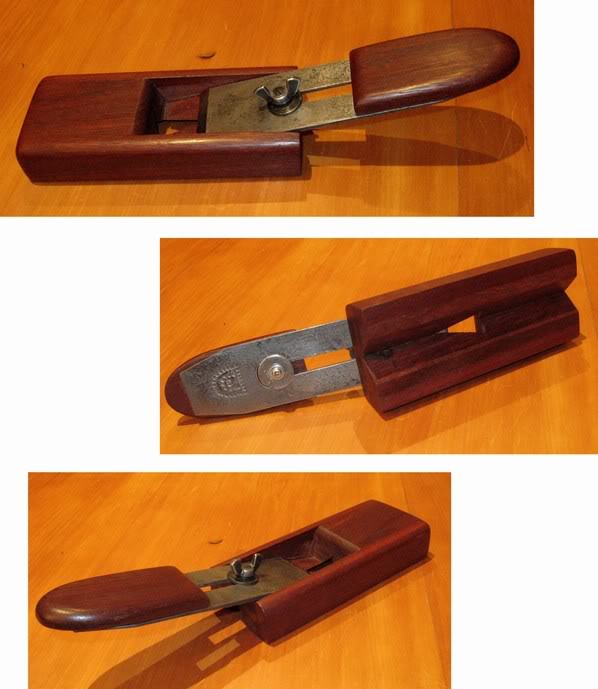Keith Cocker
Established Member
Veritas Apron Plane for me. Very satisfying to use! Makes a lovely quiet swooshing sound and delicate curly slivers of wood.

......Two folks here I know of use both, @IWW & @hennebury
If beveling isn't the sole reason that they choose to use a plane like that, then I'd like to stand corrected.....



Garrett Hack is famous for advocating scratch stock. You can find it also in Robert Wearing's books.Depends on how long the edge is. If small, regular block plane for along the grain and low angle block plane with a tight mouth for cross grain . If longer edges I'll move across to a #4, but probably still a low angle block cross grain.
I've never used a scratch stock, but having seen those beaded edges maybe I ought to revisit the idea.
Craig
Garrett was the very guy that taught me how to make and use them. I'm still cutting bits off a length of 1 inch wide bandsaw blade he gave me. Perfect for string inlays.Garrett Hack is famous for advocating scratch stock. You can find it also in Robert Wearing's books.
Not heard of these, just looked them up, price around £6 for six, or cheaper. Various sizes, grades, including one with different corners, 90 deg, rounded, acute and obtuse which looks interesting.festool granat 120 sanding block
I wonder what @Derek Cohen (Perth Oz) uses, since he has many fancy planes.
Can a high angle achieve the same polish/chatoyance as a tight set cap iron?
Personally I wouldn't chance deviating from anything without a cap iron,
but have often heard suggestions that a tight mouth might be beneficial here.
Not really done any precise long grain decorative beveling to make note of any issue
with an open mouth and it pulling off a chunk at the start of a cut....
so an interesting question to put to the folks who combine a tight mouth and some influence from the cap.
Two folks here I know of use both, @IWW & @hennebury
If beveling isn't the sole reason that they choose to use a plane like that, then I'd like to stand corrected.
Cheers
Tom

This is the kind of round that I am looking for, or even a bit smaller, just to be clearBecause Tibi asked: 'what hand tool' (singular) do you use to chamfer/round edge my immediate thought was a straight-bladed tool of some sort (plane / spokeshave) ut they both produce a sharp edge at the meeting two surfaces at an angle with one another (which also applies when producing an arris).
Tibi then went on to say: ' I do not mean excessive round/chamfer, just a small one so that the edge is not sharp' and that made me go back to the definition of a chamfer or arris as they both result in a sharp / defined edge. If a plane / spokeshave is used to 'round-over' an edge, the end result isn't 'rounded', it's facetted because a straight blade has been used to produce it - to get a 'rounded' edge, you then have to resort to an abrasive to achive the desired 'profile'.
If all Tibi wants to do is 'break / soften' an edge, isn't an abrasive the best way ?
I like lots of planes and chisels as much as the next guy, but having rows of tools to do simple operations is for the type of person who changes oil in a car with a bib and disposable suit
......having special planes or tools to strike corners or edges is probably a modern thing. The benefit of something like a #4 in hand is if it's set up to smooth, it won't create any tearout - and it's already in your hand all the time.
.......
Chamfering planes are hardly modern, unless you consider anything from the last several hundred years 'modern'.While a plane that does nothing but make chamfers may seem a bit frivolous for the average weekend wood warrior I think I'd take a different view if I had to make miles of precise chamfers as they did on all those exposed beams in old buildings...
For me, if just 'easing' or 'softening' a corner, it's usually a one-handed operation & I find it most efficient to restrain the job with one hand as I plane so it can be quickly flipped to the next corner. I guess you're a good deal younger & stronger than I am, so maybe using a #4 one-handed is no more difficult for you than using a block plane or equivalent with one hand, but a small plane is definitely easier for me to manage for easing corners. I don't enjoy pushing more tool around than is necessary to get the job done efficiently. Putting down the #4 & reaching for a small plane may expend a few calories, but they are handsomely repaid by the savings thereafter....
Cheers,
Ian

when you're taking a small chamfer, there's no reason to reset anything - if the cap iron is typically set a hundredth off or ever so slightly under, it doesn't work like a wide smoother shaving in terms of resistance (you can take a pretty healthy shaving - just advance the iron a little).
If the mouth opening is too big (it'll probably be around 1/16th on most smoothers), then the thing being chamfered is probably small enough that chisel or file would be better than a block plane.
Enter your email address to join: